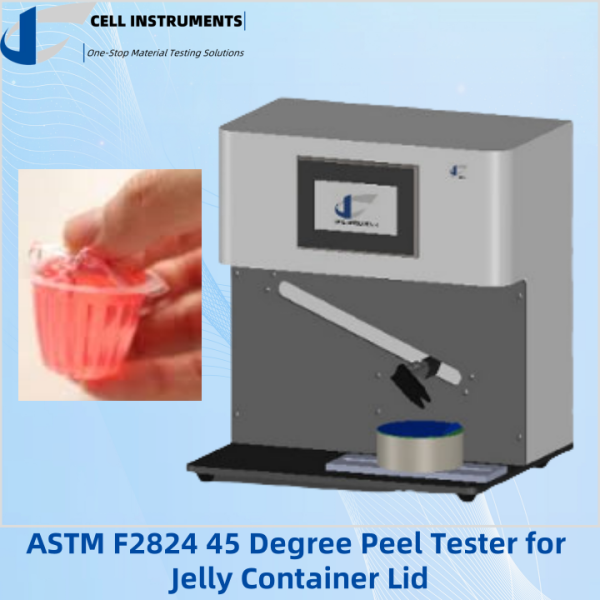Common Issues in 45 Degree Peel Tests on Jelly Container Lids and How to Solve Them
Ensuring the integrity of jelly container lids is crucial for maintaining product quality and consumer trust. The 45 degree peel test, guided by ASTM F2824, is a reliable method for assessing the peel strength of these lids. However, conducting these tests can present several challenges. This article will explore common issues encountered during 45 degree peel tests on jelly container lids and provide practical solutions.
I. Understanding the 45 Degree Peel Test
The 45 degree peel test measures the force required to peel a lid from its container at a 45-degree angle. This test is essential for verifying the seal strength of packaging materials, ensuring that lids remain secure until consumers open them.
II. Importance of the 45 Degree Peel Test
The 45 degree peel test helps manufacturers:
- Prevent contamination by ensuring a secure seal.
- Maintain product quality and freshness.
- Comply with industry standards like ASTM F2824.
III. Challenges in Testing Jelly Container Lids
1. Inconsistent Peel Strength
Issue: Variability in peel strength readings can lead to inconsistent test results. Solution: Ensure proper calibration of the peel tester before each test. Use the Cell Instruments CCPT-01 Container Lids Peel Tester, which features high precision and accuracy, reducing variability.
2. Improper Sample Preparation
Issue: Inconsistent sample preparation can affect test outcomes. Solution: Follow a standardized sample preparation procedure. Secure the jelly container lid properly in the tester’s fixture, ensuring the peel line is correctly aligned.
3. Environmental Factors
Issue: Temperature and humidity variations can influence peel strength. Solution: Conduct tests in a controlled environment. The CCPT-01 tester can be paired with environmental control systems to maintain consistent conditions.
4. Operator Errors
Issue: Human errors during the setup or execution of the test can skew results. Solution: Utilize automated features of the CCPT-01, such as the automatic return to the original position and customizable test parameters, to minimize operator intervention.
5. Data Interpretation Challenges
Issue: Misinterpreting test data can lead to incorrect conclusions about lid quality. Solution: Use the automated data recording and analysis capabilities of the CCPT-01 to obtain accurate force measurements and comprehensive data analysis.
IV. Solving Common Issues with the CCPT-01 Container Lids Peel Tester
The CCPT-01 Container Lids Peel Tester by Cell Instruments is designed to address these common issues effectively:
- High Precision and Accuracy: The tester ensures consistent peel strength measurements, reducing variability.
- User-Friendly Interface: The PLC and HMI color touchscreen make the instrument easy to operate, minimizing operator errors.
- Customizable Test Parameters: Allows for precise control over test conditions, ensuring consistent sample preparation.
- Environmental Control Compatibility: Can be used in conjunction with environmental control systems to maintain consistent testing conditions.
- Automated Data Analysis: Simplifies data interpretation, providing accurate and reliable results.
V. Compliance with ASTM F2824
Adhering to ASTM F2824 ensures that the 45 degree peel test is conducted according to industry standards, enhancing the credibility and reliability of test results.
Key Steps in ASTM F2824
- Calibration: Confirm the calibration of the force-measuring device.
- Sample Setup: Secure the container and align the peel line accurately.
- Testing Procedure: Set the peel rate to 12 ± 0.5 in./min (300 ± 12.7 mm/min) and initiate the test.
- Data Recording: Record the results and repeat the procedure for additional samples.
VI. FAQ
A1: It measures the force required to peel a lid from its container at a 45-degree angle, ensuring the seal’s strength.
A2: It helps ensure the lids are secure, preventing contamination and maintaining product quality.
A3: The CCPT-01 offers high precision and automated features, reducing variability and operator errors.
A4: Inconsistent peel strength, improper sample preparation, environmental factors, operator errors, and data interpretation challenges.
A5: By providing standardized procedures, ASTM F2824 ensures consistency and comparability of test results.
The Cell Instruments CCPT-01 Container Lids Peel Tester is an essential tool for ensuring the quality and safety of jelly container lids. By addressing common testing challenges and complying with ASTM F2824, manufacturers can achieve reliable and accurate peel strength measurements.
Related Product
Related Article
Cup and Container Peeling Tester
Measure the Seal Strength of Peel Lids for Jelly Cups
Peel Tester for Instant Cup Noodle Lid

